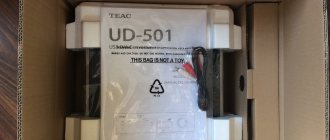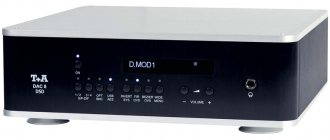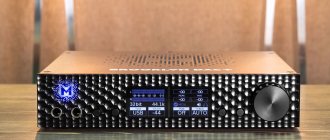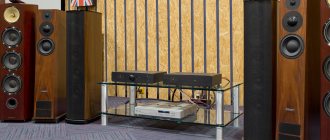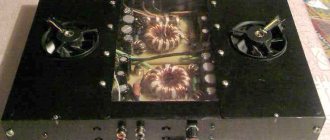Three years ago, Magni and Modi microcomponents became iconic models, with the help of which Schiit managed to earn serious popularity among the broad masses of music lovers. But time passes, competitors are not asleep, and now the third edition of these compact devices has been born.
However, the phrase “third edition” is not entirely appropriate here. Indeed, the names of both heroes of the test contain triplets, but their pedigree is not as simple and straightforward as it might seem at first glance. For example, the Modi DAC was initially offered in two versions - standard and multibit, and in terms of sound, as you might guess, they differed quite significantly. Well, Modi bifurcated in the second generation: the Modi 2 Uber modification received additional digital ports and an external power source.
From digital to analog with Schiit Modi 3
The continuation of this excellent (with a German accent) version is the Modi 3. In its external design, the most significant change was the replacement of the input selector button with a small three-position switch. In my opinion, this only benefited both the appearance and the internal structure.
A polished steel rod looks neater than a deliberately roughly machined aluminum disk - moreover, it is associated with military or aviation equipment from the end of the last century. I think that from the point of view of signal transmission quality, it is also at least no worse than an inexpensive electronic selector. By the way, the three LEDs on the front panel have also disappeared: the toggle switch is an excellent indicator in itself.
But the set of digital inputs remains the same. The same ubiquitous pair of coaxial and optical SPDIF plus the unchanged USB 2.0. However, he changed the connector: instead of the bulky but absolutely indestructible USB B, a compact but much less physically durable USB Micro was found on the rear panel.
Nowadays, everyone has plenty of cords with this connector (except for radical fans of Apple technology), but their reliability and convenience leave much to be desired. It would be much more logical to replace the good old type B with the fashionable and progressive type C.
Parts are made of turned and stamped aluminum and look decent and do not require high precision processing
It's not every day you see Micro USB ports on the back of a DAC.
But next to the signal USB port there was another one - for connecting external power. That is, if Modi 2 was equipped with an external linear power supply with a tubular connector, now you will have to choose a five-volt USB source yourself. However, a good USB - USB Micro power cord is still included in the package. By the way, if the quality and power supply of the digital source allows, our hero can easily receive power through the signal port.
With the exception of the OPA1662 op-amp, the set of chips remained the same as in Modi 2 Uber
As for the circuitry, like its predecessors (with the exception of Modi Multibit, of course), the device is built on the well-known AK4490 DAC from Asahi Kasei Microdevices, and the USB controller is a low-jitter C-Media CM6631A chip. The OPA1662 operational amplifier with precision thin-film resistors is responsible for active filtering and analog summation. This last point is especially important because, unlike the previously used Analog Devices AD8616, the new chip from Texas Instruments boasts significantly lower noise levels and extremely low distortion (0.00006% at 1 kHz).
From weak to strong with Schiit Magni 3
Now let's move on to the second brother - Magni 3. By the way, the names themselves clearly hint at the blood relationship of this couple. If anyone has forgotten, in Scandinavian mythology the names Modi and Magni are borne by the two sons of the god of thunder, storms and war - Thor.
The Magni 3 model was a direct continuation of the Magni 2 Uber modification, and since there is no elite “Uber” variety in the third generation, it is logical to assume that Schiit simply decided to transfer all the bonus goodies to the main line. And the main one is the pre-amplification output, which allows you to connect not only headphones, but also active monitors to the miniature box, and a relay delay of the signal protects the output devices and the ears themselves from unpleasant interference when turned on. In principle, even powerful terminals with floor-standing acoustics can be attached to the box, although such an installation will look rather eccentric from the outside.
It’s better not to put anything on top of the amplifier - it gets pretty hot
With such a miniature case, the toggle switches on the rear panel do not cause any inconvenience
And now the main news: the topology of the Magni 3 amplifier path is very different from that of all its predecessors. According to taciturn official information, a high-speed (apparently, we are talking about the rate of rise of the input voltage) circuit with current feedback, built entirely on discrete elements, is used here. The developers report without false modesty that such solutions are usually found in equipment that is ten times more expensive.
Judging by the passport data, the redesign turned out to be very effective. At a load of 32 Ohms, the amplification power increased from 1.5 to 2 W, and nonlinear distortion decreased exactly by half and now amounts to less than 0.001% (20 Hz - 20 kHz, 1 V RMS). In turn, the signal-to-noise ratio increased from 104 to 108 dB.
Using a printed circuit board is just the right time to study the basics of amplification circuitry.
As for appearance, there are also changes, albeit very small ones. The aluminum volume control drum has a less rounded edge, and its current position is now determined not by a small hole, but by an oblong mark. It's a pity that the designers didn't go even further and tint it with paint - then it would have become even more noticeable.
The changes did not affect the rear panel at all. There are two pairs of “tulips” (input/output) and a gain switch (6/17 dB) on it. Unlike the DAC, the Magni 3 still comes with a hefty 14V linear power supply.
From bass to treble
One of the first things that definitely pleased me and demonstrated the superiority of the Magni2 over cheaper alternatives was the control of the bass range. In this regard, the Tonino Lamborghini headphones became the most revealing. Both models are quite demanding on the amplifier's capabilities, and if there is not enough power or damping factor, the bass sound becomes booming and uncontrollable. The Magni2 demonstrated excellent bass control even on challenging content such as the Arctic Monkeys' AM album. There were no problems with the other headphones either, and only on the Beyerdynamic DT-770 the bass was a little boomier and blurred at low notes, which, however, was not annoying and was perceived rather as a specific sound of these headphones.
You can safely experiment with the selection of headphones, but within reasonable limits
Further comparisons with portable devices and standard headphone outputs seemed, frankly, pointless. The kit was better in all respects, but that is precisely what it was created for - to rise one or more degrees of quality above standard solutions.
The stage is wide, indicating good channel separation. Riding with the King didn't try to bunch up inside the head; instead, Eric Clapton and B.B. King were located somewhere in the ear cups. Enya's recordings conveyed the space and atmosphere of the recording very well. The resolution that this set provided made it possible to experience the audiophile benefits of Dire Straits recordings, although it did not bring out absolutely all the details. But the dynamics were simply excellent! This was felt well on Alex Clare and other energetic music, including hard rock and simple metal. Dance and pop music sounded very good, especially energetic and bright things (like Sia's albums), and Michael Jackson's hits demonstrated some kind of incredible articulation of vocals and clarity of rhythm - I didn't even think that these qualities could feel redundant.
It’s difficult to expect big and high-quality sound from this pair, so the small Schiit is especially surprising
In general, the set paints a sound picture with large strokes characteristic of the American sound school, while being very rhythmic and bold, which makes any recording, even of low quality, seem very expressive. When listening to low-quality masterings, the result was very pleasing. The compression is audible, it is clear that the detail of the recording is low, but the musical part suffers minimally from this. You can listen to any quality content, even MP3, without discomfort. Attention is focused not on defects, but on the artistic component. This property is very relevant, because from a computer we play not only Hi-Res recordings, but also listen to Internet radio and streaming services that cannot boast of a high bitrate. And music videos on YouTube have not been canceled.
Purity of the experiment
For testing, I mainly used open magnet planar headphones Audeze LCD-2 Classic (70 Ohm, 101 dB/W/m), periodically changing them to much higher impedance Sennheiser HD 650 (300 Ohm, 103 dB/W/m). By the way, at this impedance Magni 3 produces 0.43 W versus 0.32 W for Magni 2 Uber. Looking ahead, I will say that such an addition turned out to be not at all superfluous and introduced a good supply of respectable solidity into the sound.
The interconnects will need to be extremely short
As for the input signal, traditionally for Schiit, the Modi 3 DAC does not support DSD, but it accepts PCM up to 24 bit/192 kHz via USB and coaxial with optics.
For the purity of the experiment, I separated our couple for a while, listening to the Modi 3 with a different amplifier, and the Magni 3 with a different DAC. However, predictably, no inconsistencies in the characters of the sound were found - the components were clearly created precisely with the expectation of harmonious joint work.
The sound is light and transparent
The AK4490 converter installed in Modi 3 occupies the second oldest position in the audiophile Verita series, which boasts a modified delta-sigma modulation mechanism that significantly reduces the level of high-frequency quantization noise. For fine tuning of the sound, the chip provides five digital filtering modes, and which one Schiit engineers chose is anyone’s guess. If for Magni 2 Uber, as it seemed to me, a neutral and voluminous Slow Roll-off was chosen, then I would venture to suggest that a transition to Short Delay Sharp Roll-off is quite likely here. In any case, its characteristic slight emphasis on the bass is felt.
If we talk about the sound of the set as a whole, it makes a very positive impression. This feeling consists of several components. Firstly, the sound is light and transparent (which indicates a truly low level of distortion), and this character can be seen on headphones with almost any impedance, for which special thanks to the very low output impedance of Magni 3 (<0.3 Ohm, regardless of the gain ).
In addition to transparency, it is worth noting the plasticity and relief of the vocal range - I didn’t think that I would have to talk about such subtle matters in the test of apparatus for 12,000 rubles! Nevertheless, this couple really produces a very worthy, one might even say, thoroughbred sound.
However, purists will probably be wary of its slight emphasis on bass and treble. However, their emphasis is so subtle that the vast majority of potential owners will perceive it simply as a live, detailed reproduction. If only because not everyone will decide to buy headphones that cost three times more than the amplification path. And more budget solutions will inevitably become a bottleneck - the kit really costs much more than it costs. Moreover, when compared with the previous generation, this gap has definitely increased.
Without unnecessary harshness
The source of the digital stream for testing was a MacBook Pro laptop and a Huawei P10 smartphone. In the first case, the Amarra Symphony player was used, in the second, the USB Audio Player Pro. The output was connected to a tube classmate of Modi called Vali 2, as well as several transistor amplifiers of different classes.
I remember quite well how the delta-sigma incarnations of Modi sound, so I can’t help but state that in terms of sound these are really two completely different devices. First of all, you pay attention to the open space and impressive microdynamics.
In well-recorded symphonic music, you immediately feel air and flight, that is, precisely those properties from the lack of which classical lovers with budget systems primarily suffer.
The resolution at high frequencies has grown considerably, and if paired with Vali 2, the struggle for purity and naturalness of the highs resulted in long experiments with cables and headphones, but with solid-state equipment of a fairly high class, everything turned out to be completely different. The sound of percussion and brass shone and sparkled just like the instruments themselves in the photographs, and the bow instruments did not at all try to merge into a homogeneous mass. At the same time, there was not a drop of unnecessary harshness in the sound.
The bass turned out to be not overfed, but quite deep, mobile, and with a well-developed structure. Such a presentation sometimes does not get through to fans of club low-ends, but this is a special caste - they do not always manage without correction on bass paths.
As an experiment in practicing difficult vocals, I staged Mozart's The Magic Flute with Diana Damrau, one of the highest coloratura sopranos in the world. The first sensations are depth, transparency and sonority, the latter epithet in the best sense of the word. If we compare the nature of the presentation with the top Yggdrasil DAC, then the timbre structure of the voice was, perhaps, a little simplified, although almost as prominent. The same can be said about microdynamics: if we take as a starting point not the Modi brothers, but the more expensive Schiit multi-beaters, the sound has a slight roundness and smoothness, giving a feeling of almost tube-like plasticity.
That is, a certain paradox arises: if the Vali 2 amplifier for a tube design plays unexpectedly quickly and collectedly, then its partner Modi Multibit presents the sound a little less formally, without the fundamental pedantry of the top DAC models.
The switch is on the back as always, but in this case there is no problem
As for the final sound of this pair, it will be determined mainly by the characteristic features of Vali 2. For the simple reason that Modi Multibit is definitely the stronger link here. And when I talk about plasticity, I'm not referring to the cotton tops, but to the fact that its character is a little softer, more human if you like, than that of precision instruments called Yggdrasil and Bifrost Multibit.


